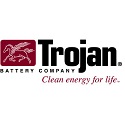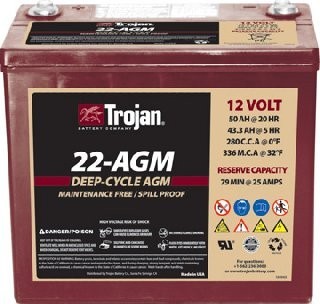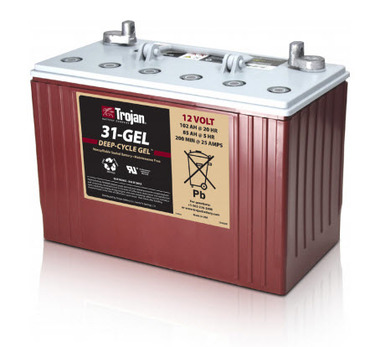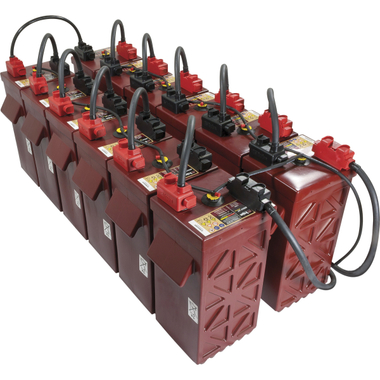 Loading... Please wait...
Loading... Please wait...Products
- Solar Panels
- Solar Panel Kits
- Solar Generators
- Inverters
- Inverter Monitoring
- Inverter Accessories
- Balance of Systems
- Racking and Mounting
- Rails
- Flashings
- Splice Kits
- Stopper Sleeves
- Conduit Mounts
- Attachments
- Brace Assembly
- Base Mount
- Brackets
- Bolts
- Clamps
- Caps
- L-Feet
- Washers
- Skirt
- Lugs
- Tilt Legs
- Hooks
- Stand-Offs
- Ballast Bay
- Top of Pole Mount
- Side of Pole Mount
- Flush Mount Kits
- Ground Mount Kits
- Roof Mount Kits
- Hardware Packages
- Wire Management
- Batteries
- Battery Accessories
- Charge Controllers
- Tools and Supplies
- View All Products
Solaris Blog - Trojan Battery Maintenance
Complete Maintenance Guide for Trojan Batteries
Posted by Brandi Casey on 11th Apr 2017
Trojan Battery Company is one of the leading solar battery manufacturers, their batteries have one of the longest lifetime expectancy and energy output in the industry. In order to keep any battery working at their peak industry output it is important to ensure that the batteries are properly maintained. Most battery first time battery back-up systems go out before their expected life-time due to poor battery maintenance practices. Luckily, Trojan Battery Company has a set of guidelines that will aid you in maintaining any battery and possibly extend their lifetime past their warranty period.
Keep in mind that every battery is unique and thus has different maintenance requirements. Whether differences in battery time, charger technology, equipment loads, cable size, climate and more are slight or significant, the differences will require that battery maintenance is adjusted. That being said, also ensure that the battery you select is what will work best for both your individual project and environment. Also, every system is different so customizations to battery maintenance will always need to be made, however the Trojan Battery guideline serves as a great foundation for proper battery maintenance.
Battery Types:
The primary application for lead-acid batteries is car batteries, deep-cycle lead-acid battery application is broken down to specific applications such as RV, golf cars, floor scrubbers, renewable energy, marine and more. The two popular construction types are: Flooded Batteries (Wet) and VRLA batteries (Valve-Regulated Lead Acid). Flooded batteries contain we electrolyte (acid in water) which can spill if it is tipped over or overfilled. In VRLA batteries, the electrolyte is suspended in a gel or fiberglass-mat (AGM technology). This technology makes these batteries non-spillable.
For any battery backup system, we recommend having these tools on hand:
- Wrench
- Distilled Water
- Voltmeter
- Hydrometer
- Post Cleaner
- Baking Soda
- Vaseline
- Googles & Gloves
In additional always make sure you wear protective clothing such as gloves and googles each time you handle your batteries.
Visual Inspection:
It is important to get into a routine of inspecting your batteries, we recommend trying to check your batteries at least once a month and keeping accurate logs of battery levels and performance.
- Examination
- Check for cracks in the container
- On the top of the battery, check the posts and connections should be clean, free of dirt, fluids, and corrosion
- Check all battery cables and their connections
- Signs of Damage
- Any fluids on or around the battery is an indication that an electrolyte is spilling, leaching, or leaking out
- Broken or frayed cables can be extremely hazardous, battery cables should be intact, replace any cable that looks remotely damaged
- General Maintenance
- Tighten all wiring connections to the proper specifications (See Proper Torque Values Below)
- Make sure there is good contact with the terminals
*Trojan 22-AGM Sealed AGM Battery
Torque Values:
- Flooded: 65 to 75 in-lbs
- VRLA: 90 to 100 in-lbs
Ensure that you do not over-tighten the terminals, over-tightened terminals can result in breakage, post meltdown and fire.
Testing:
Although visual testing can identify and prevent major problems, it is not enough to determine your batteries overall health. Voltage and specific gravity readings will provide a good indication of the battery’s charging level, age and health. These tests are designed to help spot signs of improper care and possibly locate a bad or weak battery.
- Specific
Gravity Test (Flooded Batteries Only)
- Fill and drain the hydrometer 2-4 times before pulling out a sample
- There should be enough sample electrolyte in the hydrometer to completely support the float.
- Take a reading, record it, and return the electrolyte back to the cell
To check another cell, repeat the above steps, ensure that you check all cells in the battery. Replace the vent caps and wipe off any electrolyte that might have been spilled. Correct the readings to 80°F: Add .004 to readings for every 10° above 80°F, subtract .004 for every 10° below 80°F. Compare the readings, they should be at or above the factory specification of 1.277 (±.007). If any specific gravity readings register low, follow the below steps
- Check and record voltage level(s)
- Put battery(s) on a complete charge
- Take specific gravity readings again
- If any specific gravity readings still register low then
follow the below steps.
- Check voltage level(s)
- Perform equalization charge. (Refer to Equalizing section for the proper procedure)
- Take specific gravity readings again
- If any specific gravity reading still registers lower than
the factory specification of 1.277 (±.007) then one or more of the following
conditions may exist:
- The battery is old and approaching end of life
- The battery is left in a state of discharge too long
- Electrolyte was lost due to spillage or overflow
- A weak or bad cell is developing
- Battery was watered excessively previous to testing
*Trojan 31-GEL Sealed Gel Battery
- Open-Circuit Voltage Test – For accurate voltage
readings batteries must remain idle (n charging, no discharging) for at least 6
hours, preferably 24.
- Discount all load from the batteries
- Measure the voltage using a DC voltmeter
- Correct the readings to 80°F
- Add .028 per cell for every 10° above 80°F
- Subtract .025 per cell for every 10° below 80°F
- Check the state of charge with Table 1
- Charge the battery if it registers 0%-70% charge
If the battery registers below the Table 1 values, the following conditions may exist:
- The battery was left in a state of discharge too long
- The battery has a bad cell
Batteries in these conditions should be taken to a
specialist for further evaluation or retired from service.
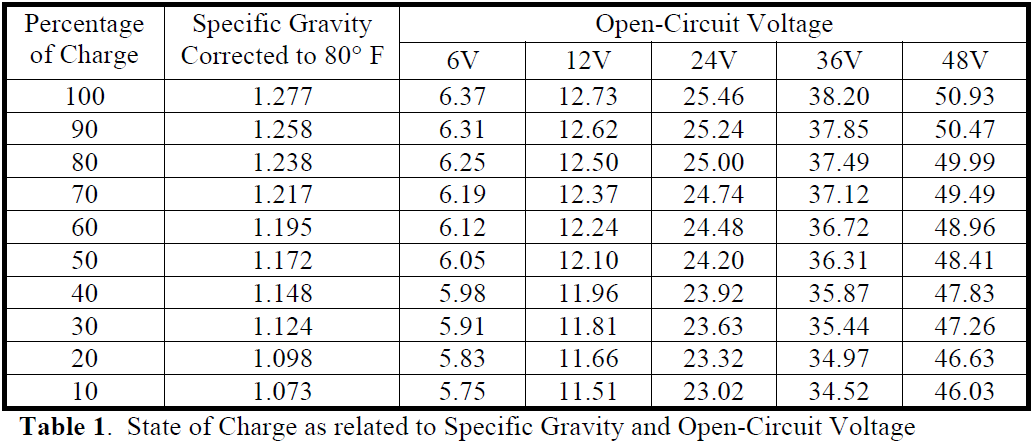
Watering (Flooded
Batteries Only):
Battery watering must be done at the right time and in the
right amount or the longevity and performance of the battery declines.There are two levels for battery water: the
first is when a battery is discharged (partially or fully). In this level, the water
only needs to cover the plates. The second, after fully charging the battery, requires
the water level to be filled just below the end of the plastic filling well.
- Important Things to Avoid:
- Do not let the plates get exposed to air as this will corrode the plates.
- Do not fill the water level above the filling well to the cap, this will likely cause an overflow of battery acid.
- Do not use water with a high mineral content. Use distilled or deionized water only.
The frequency of watering your batteries depends on your
climate, charging methods and application that the batteries are being used.
Check the batteries once a month and keep accurate records of your batteries
levels and performance to get an idea as to how your batteries are behaving.
- Watering Procedure:
- Minimum electrolyte level is at the top of the plates.
- Open the vent caps and look inside the fill wells.
- If necessary add just enough water to cover the plates at this time.
- Put batteries on a complete charge before adding any additional water.
- Charge batteries completely.
- Open the vent caps and look inside the fill wells.
- Add water until the electrolyte level is 1/8” below the bottom of the fill well.
- A piece of rubber can be used safely as a dipstick to help determine this level.
- Clean, replace, and tighten all vent caps.
https://www.solaris-shop.com/search.php?search_query=trojan+watering+kit
*To streamline the watering process, take a look at Trojan's Battery Watering System
Cleaning:
Batteries attract numerous debris such as dust, dirt and grime. Proper cleaning will ensure that you spot any signs of damage, and void corrosive responses associated with improper care.
- Check that all vent caps are tightly in place.
- Clean the battery top with a cloth or brush and a solution of baking soda and water.
- When cleaning, do not allow any cleaning solution or other foreign matter to get inside the battery.
- Rinse with water and dry with a clean cloth.
- Clean battery terminals and the inside of cable clamps using a post and clamp cleaner.
- Clean terminals will have a bright metallic shine.
- Reconnect the clamps to the terminals and thinly cost them with petroleum jelly (Vaseline) to prevent corrosion.
- Keep the area around the batteries clean and dry.
Storage:
- The most important things to avoid:
- Freezing – Avoid locations where freezing temperatures are expected. Keeping your batteries at a high state of charge will also assist in preventing freezing. Freezing can result in irreparable damage to the battery’s plates and container.
- Heat – Avoid direct exposure to heat sources, such as radiators or space heaters. Temperatures above 80°F accelerate the battery’s self-discharge characteristics.
- Step-by-Step Storage Procedure:
- Completely charge the battery before storing.
- Store the battery in a cool, dry location, protected from the elements.
- During storage, monitor specific gravity (flooded) or voltage. Batteries in storage should be given a boost charge when they show a 70% charge or less.
- Completely charge the battery before re-activating.
- For optimum performance, equalize the batteries (flooded) before putting them back into service. Refer to the Equalizing section for this procedure.
Charger Selection:
Typically, most deep-cycle applications have a charging system in place for battery charging. However, some systems with deep-cycle batteries require and individual charger. When selecting a charger, the charge rate should be between 10%-13% of the battery’s 20-amp hour capacity. Chargers with lower ratings can be used, however the charging time will need to be increased.
Trojan recommends using a 3-stage charger, also known as “automatic”, “smart” or “IEI” chargers. These chargers typically have 3 charging stages: bulk, acceptance, and float.
Charging:
Charging your battery bank properly requires administering the right amount of current at the correct voltage. See the charging charts below for recommended charging parameters. Typically, charge controllers and battery listings also contain the specifications sheets, and user guides which will further assist in charging your battery bank.
- Best Practices in Charging
- Become familiar with and follow the instructions issued by the charger manufacturer.
- Batteries should be charged after each period of use.
- Lead-acid batteries do not develop a memory and do not need to be fully discharged before recharging.
- Charge only in well ventilated areas. Keep sparks and flames away from a charging battery.
- Verify that the charger voltage settings are correct.
- Check the water level.
- Tighten all vent caps before charging.
- Prevent overcharging the batteries. Overcharging excessive gasses (water breakdown), heat buildup, and battery aging.
- Prevent undercharging the batteries. Undercharging causes stratification.
- Do not charge a frozen battery.
- Avoid charging at temperatures above 120°F.
- Additional VRLA Charging Instructions – Do not
equalize VRLA batteries
- Become familiar with and follow the instructions issued by the charger manufacturer.
- Verify charger has the necessary VRLA settings.
- Set charger to VRLA voltage settings.
- Do not overcharge VRLA batteries. Overcharging will dry out the electrolyte and damage the battery.
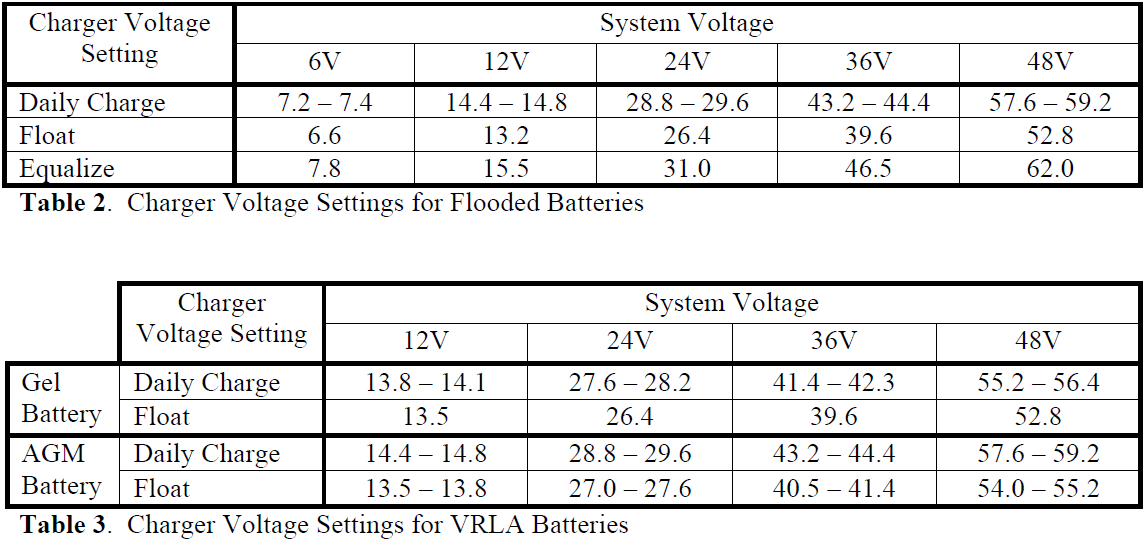
Equalizing (Flooded
Batteries Only):
Equalizing is an overcharge performed on a flooded lead-acid battery after it has been fully charged. It aids in reversing buildups for negative chemical effects, and help remove sulfate crystals that can built up on plates.
It is recommended that batteries be equalized periodically. This can range between once a month to once or twice a year. For Trojan batteries, it is recommended that equalizing takes place between (+/-.015), which are detected after the battery is fully charged.
- Step-by-Step Equalizing:
- Ensure that your charger has an equalization setting procedure.
- Verify the battery(s) are a flooded type.
- Remove all loads from the batteries.
- Connect the correct battery charger.
- Set the charger for the equalizing voltage.
- Start charging batteries.
- Batteries will begin gassing and bubbling vigorously.
- Take the specific gravity readings every hour.
- Equalization is complete when specific gravity values no longer rises during the gassing stage.
Discharging:
Discharging may or may not be required for your system. Be sure to check your users guide prior to engaging in any discharging activities.
- Shallow discharges will result in a longer battery life.
- 50% (or less) discharges are recommended.
- 80% discharge is the maximum safe discharge.
Regardless of your system, following battery maintenance protocols will ensure that you have a safe and long lasting battery backup system. Various manufacturers have differing specifications on voltages, amp hours, specific gravity and so on. However, many of the steps noted above are true for any battery backup system, particularly in maintaining, cleaning and watering your batteries.


